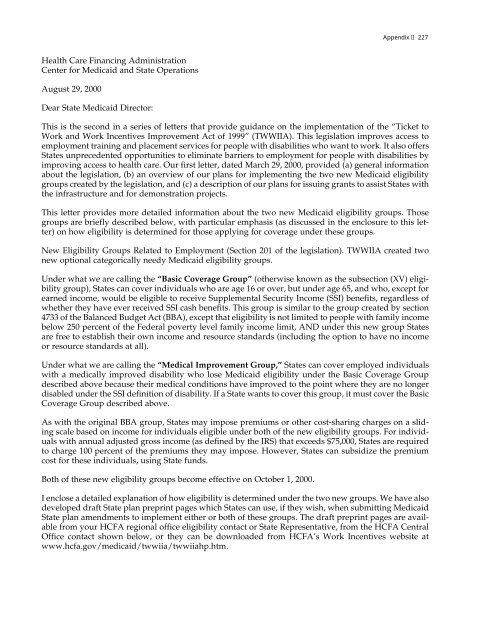Full PDF Version - ASPE - U.S. Department of Health and Human ...
Full PDF Version - ASPE - U.S. Department of Health and Human ...
Full PDF Version - ASPE - U.S. Department of Health and Human ...
- No tags were found...
Create successful ePaper yourself
Turn your PDF publications into a flip-book with our unique Google optimized e-Paper software.
Appendix II 227<strong>Health</strong> Care Financing AdministrationCenter for Medicaid <strong>and</strong> State OperationsAugust 29, 2000Dear State Medicaid Director:This is the second in a series <strong>of</strong> letters that provide guidance on the implementation <strong>of</strong> the “Ticket toWork <strong>and</strong> Work Incentives Improvement Act <strong>of</strong> 1999” (TWWIIA). This legislation improves access toemployment training <strong>and</strong> placement services for people with disabilities who want to work. It also <strong>of</strong>fersStates unprecedented opportunities to eliminate barriers to employment for people with disabilities byimproving access to health care. Our first letter, dated March 29, 2000, provided (a) general informationabout the legislation, (b) an overview <strong>of</strong> our plans for implementing the two new Medicaid eligibilitygroups created by the legislation, <strong>and</strong> (c) a description <strong>of</strong> our plans for issuing grants to assist States withthe infrastructure <strong>and</strong> for demonstration projects.This letter provides more detailed information about the two new Medicaid eligibility groups. Thosegroups are briefly described below, with particular emphasis (as discussed in the enclosure to this letter)on how eligibility is determined for those applying for coverage under these groups.New Eligibility Groups Related to Employment (Section 201 <strong>of</strong> the legislation). TWWIIA created twonew optional categorically needy Medicaid eligibility groups.Under what we are calling the “Basic Coverage Group” (otherwise known as the subsection (XV) eligibilitygroup), States can cover individuals who are age 16 or over, but under age 65, <strong>and</strong> who, except forearned income, would be eligible to receive Supplemental Security Income (SSI) benefits, regardless <strong>of</strong>whether they have ever received SSI cash benefits. This group is similar to the group created by section4733 <strong>of</strong> the Balanced Budget Act (BBA), except that eligibility is not limited to people with family incomebelow 250 percent <strong>of</strong> the Federal poverty level family income limit, AND under this new group Statesare free to establish their own income <strong>and</strong> resource st<strong>and</strong>ards (including the option to have no incomeor resource st<strong>and</strong>ards at all).Under what we are calling the “Medical Improvement Group,” States can cover employed individualswith a medically improved disability who lose Medicaid eligibility under the Basic Coverage Groupdescribed above because their medical conditions have improved to the point where they are no longerdisabled under the SSI definition <strong>of</strong> disability. If a State wants to cover this group, it must cover the BasicCoverage Group described above.As with the original BBA group, States may impose premiums or other cost-sharing charges on a slidingscale based on income for individuals eligible under both <strong>of</strong> the new eligibility groups. For individualswith annual adjusted gross income (as defined by the IRS) that exceeds $75,000, States are requiredto charge 100 percent <strong>of</strong> the premiums they may impose. However, States can subsidize the premiumcost for these individuals, using State funds.Both <strong>of</strong> these new eligibility groups become effective on October 1, 2000.I enclose a detailed explanation <strong>of</strong> how eligibility is determined under the two new groups. We have alsodeveloped draft State plan preprint pages which States can use, if they wish, when submitting MedicaidState plan amendments to implement either or both <strong>of</strong> these groups. The draft preprint pages are availablefrom your HCFA regional <strong>of</strong>fice eligibility contact or State Representative, from the HCFA CentralOffice contact shown below, or they can be downloaded from HCFA’s Work Incentives website atwww.hcfa.gov/medicaid/twwiia/twwiiahp.htm.
















